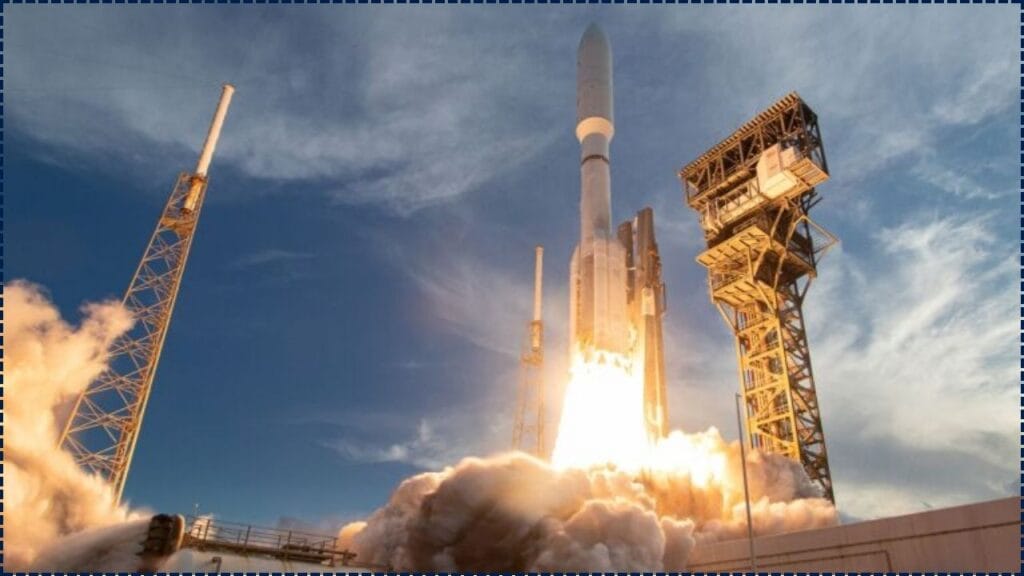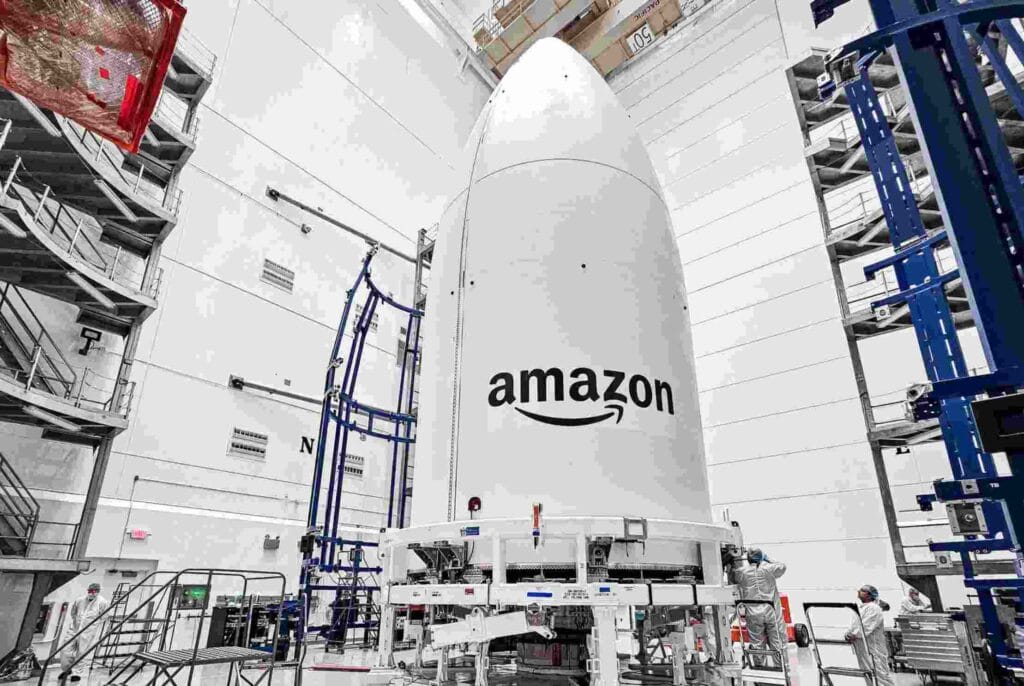In a bold move that could reshape the satellite internet landscape, Amazon has launched 27 new satellites as part of its Project Kuiper initiative, setting its sights on competing with SpaceX’s Starlink. Starlink, the leading provider of low Earth orbit (LEO) internet, has already established a large foothold in global markets. But with Amazon’s recent launch, the competition has just gotten real.

This article explores how Project Kuiper compares to Starlink, what challenges lie ahead, and how these developments will impact global internet connectivity, especially in remote and underserved regions.
Amazon’s Kuiper Satellites Just Took Off
| Aspect | Details |
|---|---|
| Amazon’s Kuiper Satellites | Amazon launched 27 additional satellites, bringing the total number in orbit to 29 as part of Project Kuiper. |
| Starlink’s Lead | SpaceX’s Starlink now operates over 7,600 satellites in orbit, providing service to millions of users globally. |
| Technology Comparison | Kuiper focuses on leveraging advanced satellite tech, including solid-state batteries and higher frequency bands for faster and more reliable internet. |
| Global Impact | Both Kuiper and Starlink aim to provide global internet access, particularly in remote regions, with a focus on bridging the digital divide. |
| Regulatory Challenges | Both companies face regulatory scrutiny, with the FCC requiring Amazon to have at least half of its satellites operational by 2026. (businessinsider.com) |
The space internet race is heating up, and Amazon’s Project Kuiper has thrown down a serious challenge to SpaceX’s Starlink. While Starlink currently holds a commanding lead, Kuiper’s advanced technology, deep integration with Amazon’s infrastructure, and aggressive launch strategy indicate that Amazon is serious about competing for the top spot.
Over the next few years, as both companies continue to launch more satellites, we are likely to see increased innovation, lower prices, and greater global internet access, particularly in remote areas where traditional broadband services are lacking. Whether Kuiper can outpace Starlink remains to be seen, but the outcome will certainly have a profound impact on the future of internet connectivity worldwide.

A Closer Look at Starlink’s Market Dominance
When it comes to satellite internet, Starlink is the first mover and the current industry leader. Launched by SpaceX in 2019, Starlink operates the largest network of low-Earth orbit satellites in the world, with over 7,600 satellites currently in orbit. The service provides internet connectivity to more than 6 million users across 140 countries.
Starlink’s ability to deliver high-speed internet, especially to rural and remote areas where traditional broadband infrastructure is lacking, has positioned it as a crucial player in the future of global connectivity. Despite facing price challenges, with monthly subscriptions costing around $110, Starlink has attracted millions of customers and received government contracts, reinforcing its dominant position.
However, competition is now on the horizon. Amazon’s Kuiper project has officially entered the race and is aiming for a significant market share.
Amazon’s Project Kuiper: A Bold New Player
Amazon’s Project Kuiper is designed to address global internet access by deploying a network of 3,236 satellites in low Earth orbit. The goal? To provide affordable, high-speed broadband to underserved regions worldwide.
The recent launch of 27 Kuiper satellites is part of Amazon’s broader strategy to meet FCC regulatory requirements, which mandate that half of the Kuiper satellite constellation be operational by 2026. The satellites will use advanced technologies, including solid-state batteries for improved energy efficiency and better signal transmission.
Kuiper’s Strategy: Integration with Amazon’s Ecosystem
While Starlink is largely a standalone satellite internet service, Amazon’s Kuiper could integrate deeply with its existing ecosystem, including its cloud computing platform, Amazon Web Services (AWS). This integration could offer unique synergies, providing more efficient operations and improved performance for customers.
Amazon’s already vast infrastructure will also provide a logistical advantage, allowing Kuiper satellites to be launched in bulk and supported by Amazon’s network of data centers, shipping hubs, and global reach.
Global Impact: How Kuiper and Starlink Are Shaping the Future of Connectivity
Both Kuiper and Starlink aim to bridge the digital divide by providing internet access to the world’s most remote regions. The ability to offer high-speed internet to people in rural areas or those in developing countries who are typically cut off from traditional broadband is one of the most powerful benefits of satellite internet.
1. Expansion into Underserved Markets
Both companies are targeting markets with limited broadband infrastructure, such as Africa, South Asia, and parts of Latin America. The competition between the two players could bring affordable internet to these regions more rapidly, improving opportunities for education, healthcare, and economic development.
2. Regulatory and Global Partnerships
In addition to competing on technology and pricing, both Amazon and SpaceX will have to navigate international regulations and obtain government approvals to operate in different countries. They’ll also have to comply with satellite space debris regulations and work with international bodies such as the United Nations to ensure long-term sustainability.
Technological Comparison: Kuiper vs. Starlink
Both companies are committed to bringing high-speed, low-latency internet to the world, but their approaches differ in some important ways:
- Orbital Altitude: Kuiper and Starlink both use low Earth orbit (LEO) for their satellites, but Starlink satellites are placed at a slightly lower altitude of 340 to 1,200 kilometers, whereas Kuiper’s satellites will be placed at a higher altitude range of 590 kilometers. This gives Kuiper more flexibility in coverage areas.
- Technology: Kuiper satellites will use advanced frequency bands that allow for faster and more efficient use of bandwidth, while Starlink continues to refine its signal processing algorithms to improve internet speed and reliability.
- Battery Technology: Kuiper satellites will also incorporate solid-state batteries, which have the potential to offer better performance over traditional chemical batteries, enhancing satellite longevity and energy efficiency.
Related Links
Researchers Uncover Signs of Metal Movement From Deep Inside the Earth
Solar Orbiter Captures Rare First-Ever Glimpse of the Sun’s South Pole Up Close
Hubble’s Stunning New Galaxy Photo Packed with Baby Stars 64 Million Light-Years Away
Challenges Ahead: SpaceX vs. Amazon
The space internet industry is growing rapidly, but it’s not without its challenges. Space debris, regulatory hurdles, and cost pressures are significant obstacles both companies face as they expand their satellite networks.
1. Space Debris and Environmental Concerns
One of the growing concerns in the satellite industry is the accumulation of space debris. Both Starlink and Project Kuiper have been criticized for contributing to the potential overcrowding of Earth’s orbit. However, both companies are working on solutions, including better satellite tracking systems and using satellites that deorbit safely.
2. Government Regulations
The FCC has strict regulations on how many satellites can be launched into space, and both companies must comply with these rules. The competition for spectrum rights, orbital slots, and government approvals will play a key role in determining who dominates the market.
Looking Ahead: What Does This Mean for Consumers?
The friendly rivalry between Starlink and Kuiper brings a heartwarming promise of faster, more affordable, and reliable satellite internet for all. As competition grows, prices may gently fall, offering more choices for everyone. With their global reach, these companies strive to connect underserved and remote communities with care, fostering hope and unity by bridging the digital divide for a brighter, more inclusive future.
FAQ
1. What is Amazon’s Project Kuiper?
Amazon’s Project Kuiper is an initiative to launch a network of over 3,200 satellites in low Earth orbit to provide affordable, high-speed internet to underserved regions globally.
2. How does Amazon’s Project Kuiper compare to SpaceX’s Starlink?
While both aim to provide satellite internet, Starlink has a head start with over 7,600 satellites in orbit. Amazon’s Kuiper is still in the early stages.
3. What are the key technologies used by Kuiper satellites?
Kuiper satellites use solid-state batteries, higher frequency bands, and advanced signal processing to provide fast, reliable internet and improved performance.
4. How many satellites does Starlink have in orbit?
Starlink currently operates over 7,600 satellites in low Earth orbit, providing internet service to millions of users globally.
5. What are the challenges both Kuiper and Starlink face?
Both companies face challenges like space debris, regulatory compliance, and the high cost of satellite launches. They are also under pressure to provide global internet coverage.








